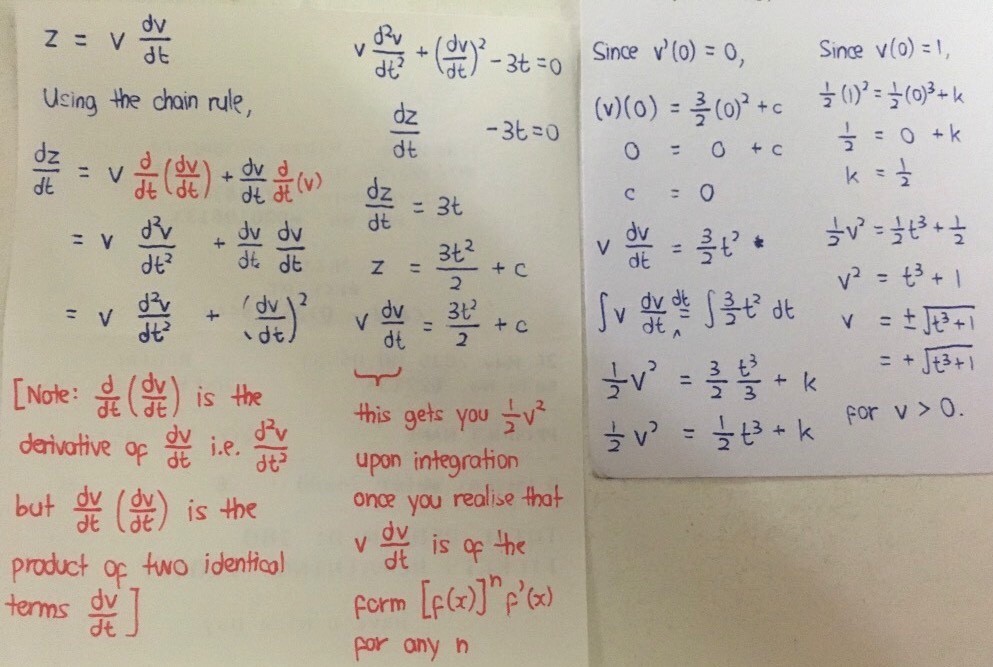Ask Singapore Homework?
Upload a photo of a Singapore homework and someone will email you the solution for free.

Question
International Baccalaureatte | Maths SL
One Answer Below
Anyone can contribute an answer, even non-tutors.

Can someone help me explain how to differentiate z=v*v' with respect to t?
d/dt (v dv/dt)
= v d²v/dt² + (dv/dt)(dv/dt)
= v (d²v/dt²) + (dv/dt)²
So,
v (d²v/dt²) + (dv/dt)² - 3t = 0
v (d²v/dt²) + (dv/dt)² = 3t
∫ (v (d²v/dt²) + (dv/dt)²) = ∫ 3t dt
v dv/dt = 3/2 t² + C, C is a constant
sub t = 0, v(0) = 1, v'(0) = 0,
C = 0
You'll have to integrate again here
∫ v dv/dt dt = ∫ 3/2 t² dt
½v² = ½t³ + D, D is a constant
Sub t = 0, v(0) = 1, v'(0) = 0,
½(1²) = ½(0³) + D
D = ½
So ½v² = ½t³ + ½
v² = t³ + 1
v = √(t³ + 1) since v > 0.
So t³ > -1 for real values of v.
This means t > -1^(⅓) = -1 for real values of v
See 1 Answer






When we differentiate t with respect to t, we obtain 1. But when we differentiate v with respect to t, we do not obtain 1, but rather, dv/dt.
Similarly, when we differentiate dv/dt with respect to t we obtain d2v/dt2.
So v*dv/dt is a product of two variables involving v and dv/dt (these two terms are related just because one is the derivative of the other, otherwise it’s just the product of two unrelated terms.
Whenever we differentiate a product of two functions of x, we use the product rule (you have learnt this last year or two years ago probably).
v is the “first term”, dv/dt is the “second term”.
By the product rule, differentiating v dv/dt with respect to t gives
“Keep the first, differentiate the second” + “Keep the second, differentiate the first”
v * d2v/dt2 + (dv/dt) (dv/dt)
But both the dv/dt mean the same thing
Hence we have v * d2v/dt2 + (dv/dt)^2
When we differentiate t with respect with t, we obtain 1 as the result.
When we differentiate v with respect to t, we obtain 1 (because v looks like t) but then we do the chain rule here to obtain dv/dt). Hence the result is dv/dt.
Similarly when we differentiate v2, we obtain 2v times dv/dt.
You can verify this by letting, say, v = 3x + 1 so that v2 becomes (3x + 1)^2 and then differentiate this expression.
It does take time to get used to these expressions though. Let me know if you need more help in this and I will do my best to explain them again.
When we differentiate v2 with respect to t,
We obtain (2) (v)^2 * (differentiate the v).
The “differentiate the v” part is the chain rule.
In general, if a function is of the form
(y^n) (dy/dx)
and we integrate this with respect to x, we obtain y^(n + 1) whole thing divided by n.
You can try differentiating y^2, y^3, y^4, y^5 etc with respect to x. At the end of each of them, you will do the chain rule to get something times dy/dx, and this is where the chain part occurs.